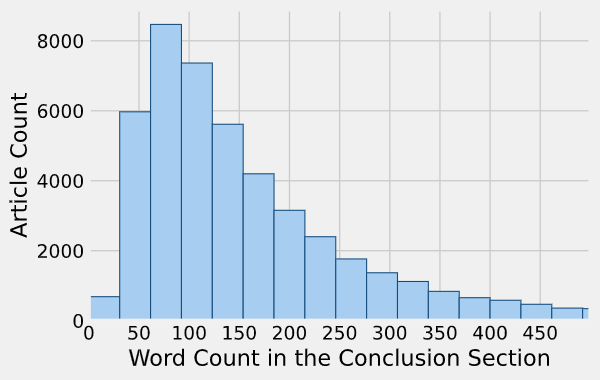I analyzed a random sample of 47,810 conclusion sections found in 98,778 full-text research papers, uploaded to PubMed Central between the years 2016 and 2021, in order to answer the questions:
When to include a conclusion section in a research paper? and how long should it be?
I used the BioC API to download the data (see the References section below).
Here’s a summary of the key findings
1- In a research article, a typical conclusion is a single paragraph section consisting of 5 sentences (130 words). Specifically, the majority of conclusion sections are either 1 or 2 paragraphs consisting of 3 to 8 sentences (81 to 220 words). That being said, some research papers have no conclusion section at all, and others have a huge 30,000 word conclusion.
2- Consider including a conclusion section especially if you’re writing:
- a long complex article: since such an article might not be read entirely in one sitting, so a conclusion is needed to summarize the text.
- a systematic review or a meta-analysis: since these articles also target non-technical readers, so a conclusion is needed to simplify the key points.
3- If you want to write a conclusion for your article, a good estimation of the word count you need can be obtained by dividing the number of words of the rest of the article by 30. For instance, a 3000 word article typically needs a 100 word conclusion.
Which types of articles need a conclusion section?
A conclusion’s objective is to summarize and simplify a large body of text, it is however an optional section. In fact, only 48.4% of all research papers in our dataset included a conclusion.
In general, longer articles are more likely to include a conclusion, since in our data, the median article with a conclusion section has a word count of 3845 (excluding the conclusion itself) versus 3344 for one without a conclusion section. This confirms the hypothesis that:
Longer texts benefit the most from a paragraph near the end that summarizes the article which might not be read from start to finish in one sitting.
The data also show that 58.1% of review papers (i.e. systematic reviews and meta-analyses) include a conclusion section, which is a higher percentage compared to other study designs (see table below). This may be due to the fact that:
Review papers typically cover a wide subject for a wide audience, and therefore need a conclusion paragraph that simplifies the key takeaway points.
Here’s a table that shows the most likely study designs to have a conclusion section:
| Percentage of Articles With a Conclusion Section | |
|---|---|
| Review Designs (Systematic Review, Meta-Analysis) | 58.1% |
| Descriptive Designs (Case Report, Case Series) | 56.9% |
| Observational Designs (Cross-Sectional, Case-Control, Cohort) | 55.7% |
| Experimental and Quasi-Experimental Designs | 54.1% |
Note that these percentages were calculated using only 16,409 articles from the initial dataset in which the study design was clearly stated either in the title or in the methods section.
Length of a conclusion section
The histogram below shows that most conclusion sections have a word count between 50 and 200:

Note that in the histogram above I chose a limit of 500 words for visualization purposes although the distribution has a very long right tail. This suggests that the median provides a better summary of the data than the mean.
The following table reports different lengths of conclusion sections found in our dataset in terms of number of words, sentences and paragraphs:
| Conclusion Length (Word Count) | Conclusion Length (Sentence Count) | Conclusion Length (Paragraph Count) | |
|---|---|---|---|
| Minimum | 10 | 1 | 1 |
| 25th Percentile | 81 | 3 | 1 |
| 50th Percentile (Median) | 130 | 5 | 1 |
| Mean | 201.3 | 7.9 | 2.2 |
| 75th Percentile | 220 | 8 | 2 |
| Maximum | 30767 | 2530 | 1072 |
Although huge conclusion sections (longer than 12 paragraphs) are not that popular (less than 1% of our data), nevertheless they are present. The longest was 1072 paragraphs long! Here’s a link to the article on PubMed if you want to check it out.
This shows that the conclusion should be as long as it needs to be. So the numbers presented in the table above are only for guidance and should not limit you if you want to do things differently.
The data also support the hypothesis that longer articles require longer conclusion sections. The table below shows that a research paper that has between 1000 and 2000 words typically has a 81 word conclusion. And a paper with a word count between 5000 and 6000 has a 171 word conclusion.
| Article Size (Word Count) | Median Conclusion Word Count |
|---|---|
| (1000, 2000] | 81 |
| (2000, 3000] | 96 |
| (3000, 4000] | 115 |
| (4000, 5000] | 143 |
| (5000, 6000] | 171 |
| (6000, 7000] | 200 |
| (7000, 8000] | 225 |
| (8000, 9000] | 241 |
| (9000, 10000] | 261 |
We can summarize this table with the following rule of thumb:
When writing a conclusion for an article, the word count you need will be the number of words of the body text divided by 30.
References
- Comeau DC, Wei CH, Islamaj Doğan R, and Lu Z. PMC text mining subset in BioC: about 3 million full text articles and growing, Bioinformatics, btz070, 2019.